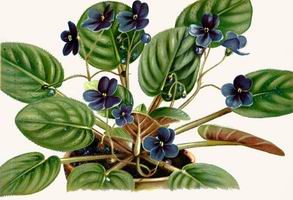
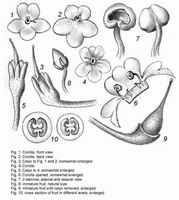
Gartenflora 42, t. 1391 (1893), orig. illustr.
Full name and orig. publication: Saintpaulia H.Wendl., Gartenflora, 42: 321, t.1391 (1893).
Etymology: Named after the family name of Ulrich (father) and Walter (son) von Saint Paul-Illaire. Walter (1860-1910) discovered the plant in 1892 in the Usambara mountains (now Tanzania).
Synonyms: -
Infrafamilial position: Didymocarpoid Gesneriaceae - "African and Madagascan genera” (Weber 2004).
Description: Perennial herbs with rosette or procumbent-caulescent habit. Stem either short and thick or procumbent, with distinct internodes rooting at the nodes. Leaves opposite or alternate, petiolate, ± fleshy, lamina suborbicular to elliptic. Cymes axillary pedunculate, one- to several-flowered; bracteoles small, linear. Sepals almost free to base, linear or lanceolate, the uppermost median. Corolla violet-blue or white; tube very short, cylindric, limb spreading at right angles to it, bilabiate, glabrous on the face, hairy on the back and (usually glandular-) ciliate on the margins. Fertile stamens two, the anterior ones; filaments inserted just within the corolla tube, stout, somewhat flattened and twisted; anthers large, robust, reniform, bright yellow, carried outside the mouth of the corolla tube, cohering face to face, dehiscing by arcuate confluent slits. Staminodes 2 - 3, usually small; abnormally 2 or all fertile (cycloidea mutants in horticulture, Harrison & al. 1999). Ovary short, conical, villous, tapering abruptly into the style; style exserted stiffly to left or right of the centre of the corolla (enantiostyly); stigma small, capitate or slightly bilobed. Fruit an ovoid to linear-cylindric capsule, tardily dehiscent. Seeds verruculose.
Chromosome number: 2n = 28, 30, 60 (the latter only in cultivars).
Species number: In his revision of Saintpaulia, Burtt (1958) recognised 19 species, a few species were described afterwards so that the number was raised to c. 22. The combination of molecular, morphological and ecological studies, however, resulted in a severe reduction in the species number. Darbyshire (2006) accepted only 6 species, while Smith et al. (1998) raised the number to 9, both authors regarding many traditional species as subspecies of S. ionantha. By the recent description of two new species (Haston 2009), the present number is 11.
Type species: Saintpaulia ionantha H. Wendl.
Species names (incl. publication and synonyms): See Skog, L.E. & J.K. Boggan. 2005: World checklist of Gesneriaceae: http://persoon.si.edu/Gesneriaceae/Checklist.
Distribution: E Africa (SE Kenya, N Tanzania).
Ecology: In hill and montane forests, usually growing on moist rocks, on slopes or by the side of streams.
Notes: Some species, especially S. ionantha and allies, are the source of numerous hybrids and "varieties", representing most popular ornamentals (see chapter "Uses"). The flat-faced, deep violet-blue, white or bicoloured blue-white corolla with exposed, bright yellow anthers exhibit the typical pollination syndrome of oligomerous pollen flowers. Buzz pollination is indicated (Harrison & al. 1999). By the robust anther walls, which still attract insects when the pollen is already shed, the flowers are deceptive to some extent (Vogel 1978). Enantiostyly is conspicuous. The distribution of the genus is remarkabley restricted, the area richest in species are the Usambara-Mts. supporting c. 15 species. Not all species exhibit the typical habit of S. ionantha, the caulescent ones (e.g., S. inconspicua B.L.Burtt, S. goetzeana Engl., S. grotei Engl., S. magungensis E.Roberts) link Saintpaulia with Linnaeopsis in habit. However, the molecular studies of Möller & Cronk (1997a,b, 2001) and Smith et al. (1998) yielded the surprising result that Saintpaulia is nested within Streptocarpus subg. Streptocarpella, while Linnaeopsis apparently evolved within subg. Streptocarpus. The origin of Saintpaulia is probably in the Uluguru Mts., with S. goetzeana Engl. and S. pusilla Engl. being probably the most primitive (relict) species (Lindqvist & Albert 1999).
Selected references: Burtt, Roy. Bot. Gard. Edinburgh 22: 547-567 (1958), rev.; ibid. 25: 191-195 (1964), new spp.; Sera & Karasawa, Bull. Hiroshima Bot. Gard. 7: 1-30 (1984), karyol.; Baatvik, Fragm. Flor. Geobot., Suppl. 2: 97-112 (1993); Möller & Cronk, Amer. J. Bot. 84: 956-965 (1997), Möller & Cronk, Proc. Roy. Soc. London B 264: 1827-1836 (1997), molec. syst., phylog., Smith et al., Edinburgh J. Bot. 55: 1-11 (1998), molec. syst.; Harrison et al., Ann. Bot. 84: 49-60 (1999), fl. develop.; Citerne et al., Ann. Bot. 86: 167-176 (2000), fl. develop.; Möller & Cronk, in Andrews et al., Taxonomy of Cultivated Plants, pp. 253-264 (1999), molec. syst., phylogeny; Lindqvist & Albert, Kew Bulletin 54: 363-377. Darbyshire, Saintpaulia, pp. 50-72, in Beentjy & Ghazanfar (eds), Fl. Trop. East Africa (2006), rev.; Haston, Curtis' Bot. Mag. 273 – 80, t. 656 & 657 (2009), new spp..
Bibliography: See Skog, L.E. & J.K. Boggan. 2005. Bibliography of the Gesneriaceae. 2nd edition: http://persoon.si.edu/Gesneriaceae/Bibliography.
Illustrations:
 |
 |
Saintpaulia ionantha Wendl., type species
Gartenflora 42, t. 1391 (1893), orig. illustr. |
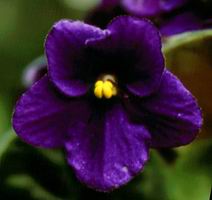 |
Saintpaulia ionantha Wendl.
Cult. BG Graz, phot. A. Weber (1980). |
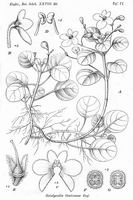 |
Saintpaulia goetzeana Engl.
Engl., Bot. Jahrb. Syst. 28, t. 6 (1894). |
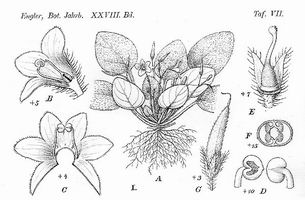 |
Saintpaulia pusilla Engl.
Engl., Bot. Jahrb. Syst. 28, t. 7 (1894). |
last modified: 2007-07-13